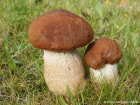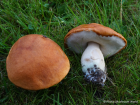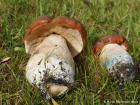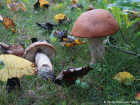Cap bright orange skin, at first round like a ball, then ovate or bun-shaped. It is sticky when damp and has, just like Leccinum versipelle, a larger skin that hangs down or is tucked under the margin of the cap. Flesh creamy-white then vinaceous or sepia were cut. Thick and firm. Pores white or cream, darkening vinaceous where bruised, circular. very small. Stem dirty white, covered with woolly scales in an irregular network, at first white then rust, stoutish, more or less equal or swollen towards the base. The stem has no ring. Spore print ochraceous-buff.
Microscopic Features: The spores are narrowly ellipsoidal to fusiform, measuring approximately 12.5-18.5 x 3.5-6µm.
Note: Leccinum aurantiacum recorded in North America may not be the same species as its European namesake.
Leccinum aurantiacum on the www.first-nature.com web site.
Many mushrooms are poisonous, and some can be lethally toxic. Distinguishing between edible and poisonous mushrooms can be very challenging. Therefore, we strongly advise against consuming wild mushrooms. This website does not contain any information about the edibility or toxicity of mushrooms.
Although efforts have been made to ensure accuracy on this website, the information may contain errors and omissions. Therefore, all content provided is for educational and informational purposes only and should not be relied upon or used as a basis for consuming any plants or mushrooms.
External links are provided for reference only. We do not endorse or take responsibility for the content, advice, or products found on these sites or in any advertisements shown on this website.





